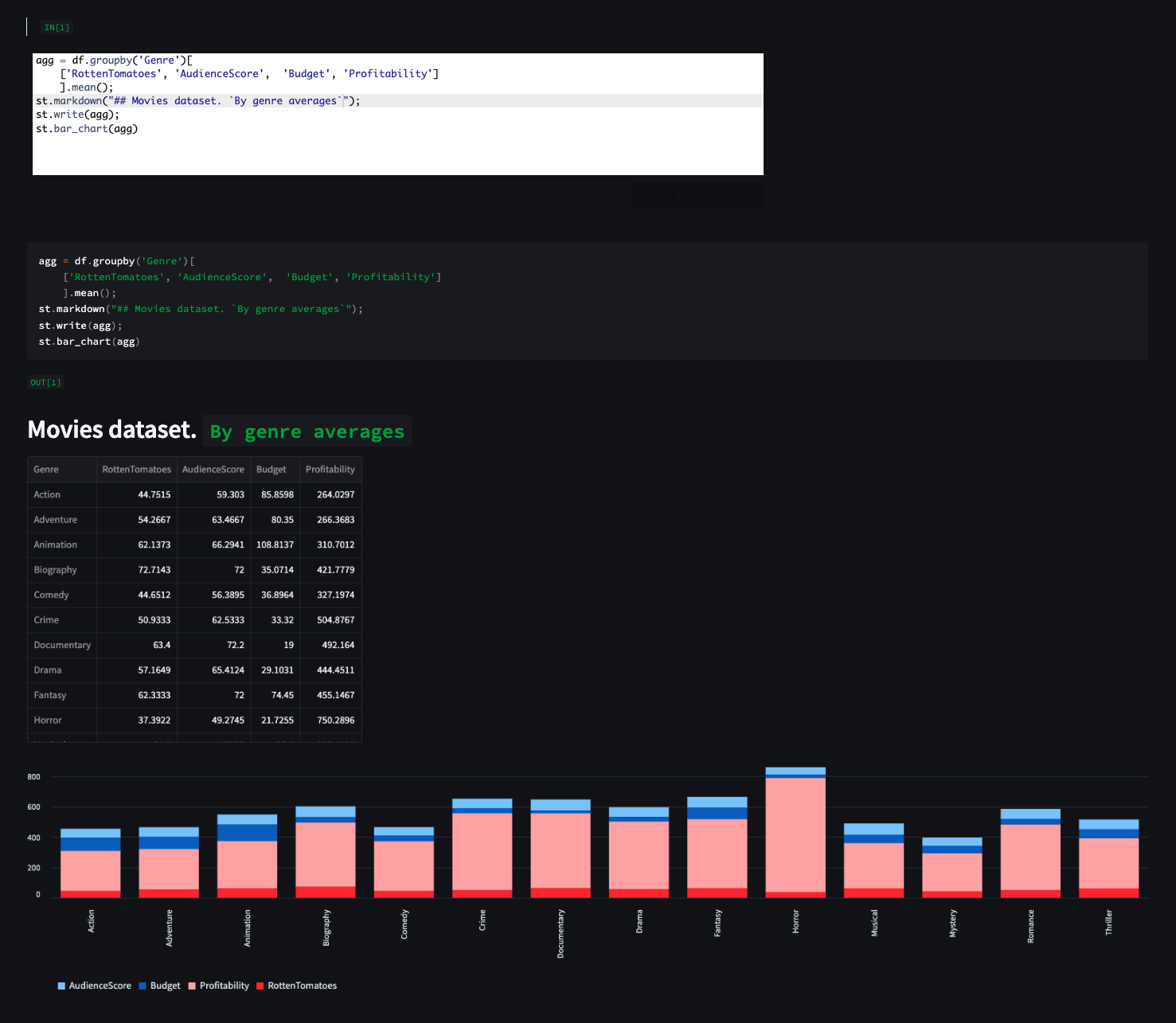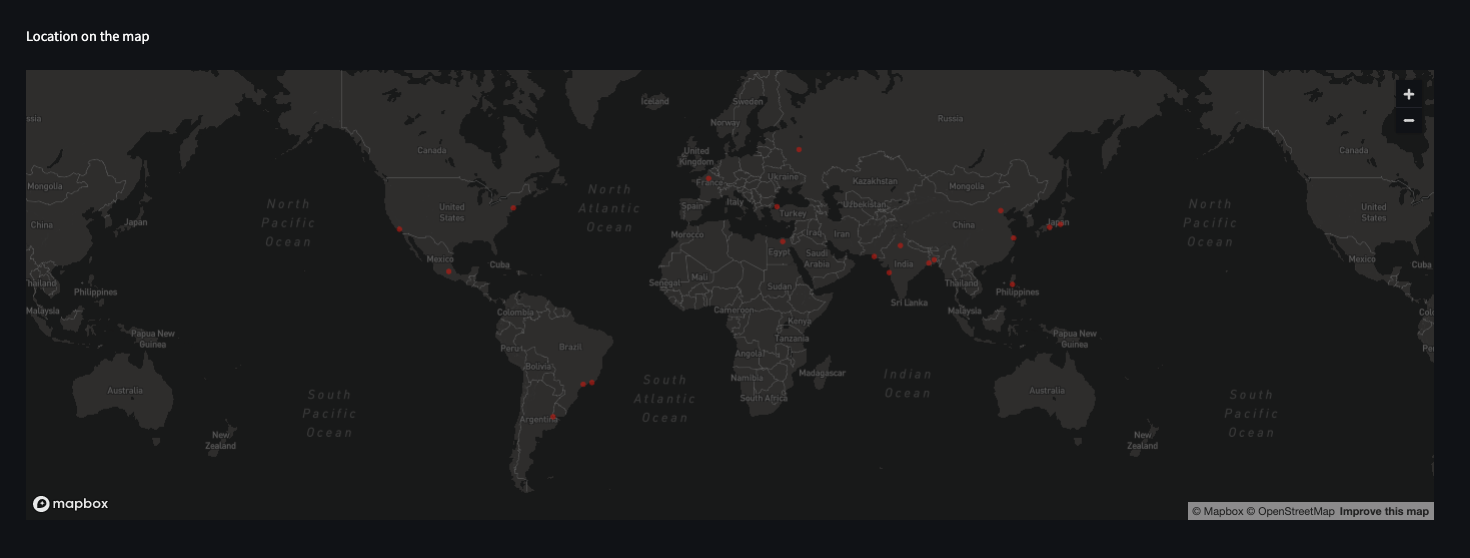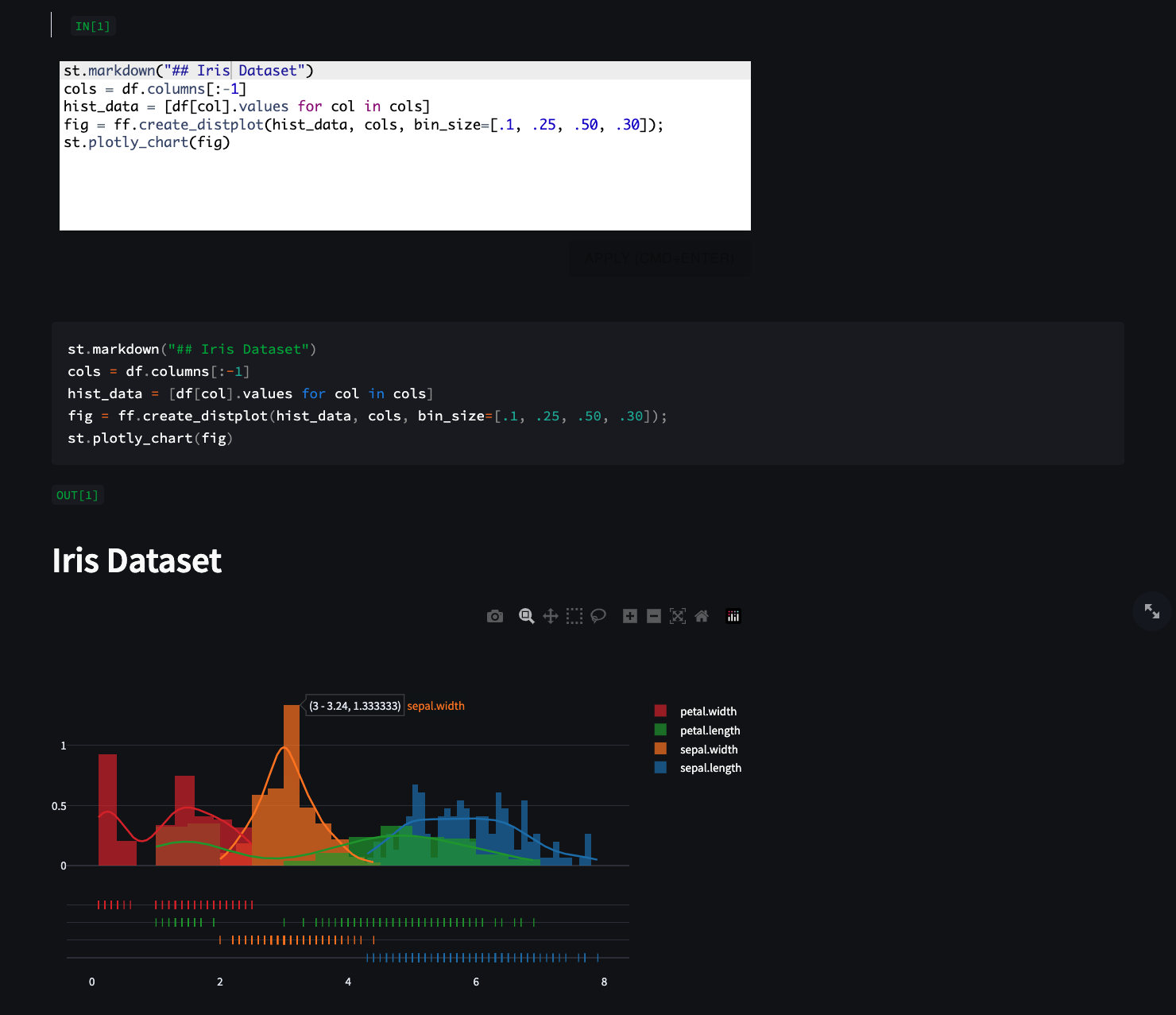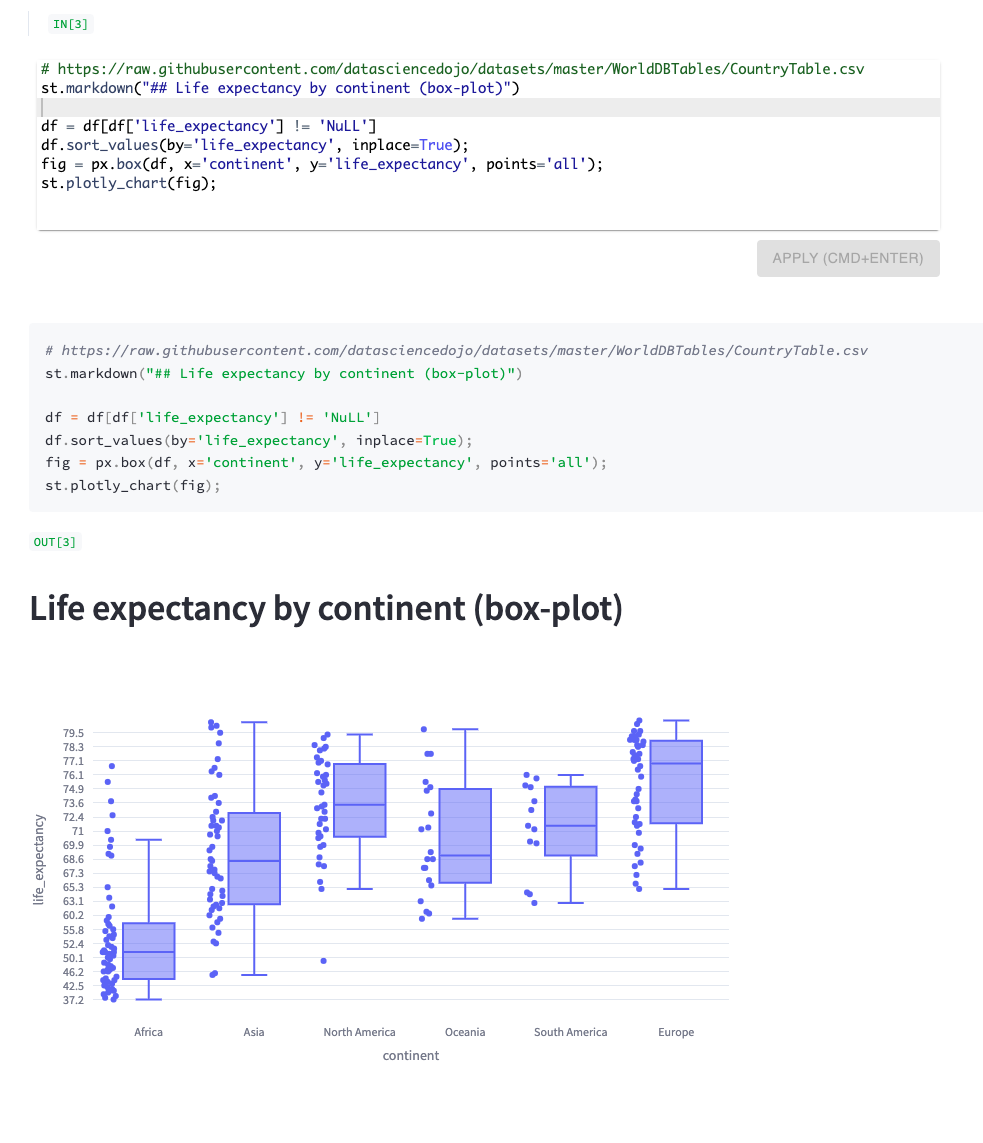import time
import os
from functools import lru_cache
import pandas as pd
import streamlit as st
import streamlit_ace as stace
import duckdb
import numpy as np # for user session
import scipy # for user session
import plotly_express
import plotly.express as px # for user session
import plotly.figure_factory as ff # for user session
import matplotlib.pyplot as plt # for user session
import sklearn
from ydata_profiling import ProfileReport
from streamlit_pandas_profiling import st_profile_report
st.set_page_config(page_title="PySQLify", page_icon="🔎", layout="wide")
st.title("Auto-PySQLify")
header = """
> _Automated Data Analysis_ Tool for analzying datasets with auto generated Python / SQL code using natural language.
> `GPT-powered` and `Jupyter notebook-inspired`
"""
st.markdown(header, unsafe_allow_html=True)
st.markdown(
"> [NYC AI Hackathon](https://tech.cornell.edu/events/nyc-gpt-llm-hackathon/) April, 23 2023",
unsafe_allow_html=True,
)
if "ANTHROPIC_API_KEY" not in os.environ:
os.environ["ANTHROPIC_API_KEY"] = st.text_input(
"Anthropic API Key", type="password"
)
if "OPENAI_API_KEY" not in os.environ:
os.environ["OPENAI_API_KEY"] = st.text_input("OpenAI API Key", type="password")
p = st.write
print = st.write
display = st.write
@st.cache_data
def _read_csv(f, **kwargs):
df = pd.read_csv(f, on_bad_lines="skip", **kwargs)
# clean
df.columns = [c.strip() for c in df.columns]
return df
def timer(func):
def wrapper_function(*args, **kwargs):
start_time = time.time()
func(*args, **kwargs)
st.write(f"`{(time.time() - start_time):.2f}s.`")
return wrapper_function
SAMPLE_DATA = {
"Churn dataset": "https://raw.githubusercontent.com/AtashfarazNavid/MachineLearing-ChurnModeling/main/Streamlit-WebApp-1/Churn.csv",
"Periodic Table": "https://gist.githubusercontent.com/GoodmanSciences/c2dd862cd38f21b0ad36b8f96b4bf1ee/raw/1d92663004489a5b6926e944c1b3d9ec5c40900e/Periodic%2520Table%2520of%2520Elements.csv",
"Movies": "https://raw.githubusercontent.com/reisanar/datasets/master/HollywoodMovies.csv",
"Iris Flower": "https://gist.githubusercontent.com/netj/8836201/raw/6f9306ad21398ea43cba4f7d537619d0e07d5ae3/iris.csv",
"World Population": "https://gist.githubusercontent.com/curran/13d30e855d48cdd6f22acdf0afe27286/raw/0635f14817ec634833bb904a47594cc2f5f9dbf8/worldcities_clean.csv",
"Country Table": "https://raw.githubusercontent.com/datasciencedojo/datasets/master/WorldDBTables/CountryTable.csv",
"World Cities": "https://raw.githubusercontent.com/dr5hn/countries-states-cities-database/master/csv/cities.csv",
"World States": "https://raw.githubusercontent.com/dr5hn/countries-states-cities-database/master/csv/states.csv",
"World Countries": "https://raw.githubusercontent.com/dr5hn/countries-states-cities-database/master/csv/countries.csv",
}
def read_data():
txt = "Upload a data file (supported files: .csv)"
placeholder = st.empty()
with placeholder:
col1, col2, col3 = st.columns([3, 2, 1])
with col1:
file_ = st.file_uploader(txt, help="TODO: .tsv, .xls, .xlsx")
with col2:
url = st.text_input(
"Read from a URL",
placeholder="Enter URL (supported types: .csv and .tsv)",
)
if url:
file_ = url
with col3:
selected = st.selectbox(
"Select a sample dataset", options=[""] + list(SAMPLE_DATA)
)
if selected:
file_ = SAMPLE_DATA[selected]
if not file_:
st.stop()
placeholder.empty()
# kwargs = {"skiprows": st.number_input("skip header", value=0, max_value=10)}
kwargs = {"skiprows": 0}
try:
return _read_csv(file_, **kwargs)
except Exception as e:
st.warning("Unsupported file type!")
st.stop()
def display(df):
view_info = st.sidebar.checkbox("view data types")
st.dataframe(df, use_container_width=True)
# info
st.markdown(f"> shape `{df.shape}`", unsafe_allow_html=True)
if view_info:
types_ = df.dtypes.to_dict()
types_ = [{"Column": c, "Type": t} for c, t in types_.items()]
df_ = pd.DataFrame(types_)
st.sidebar.subheader("TABLE DETAILS")
st.sidebar.write(df_)
def code_editor(language, hint, show_panel, key=None, content=None):
# Spawn a new Ace editor
placeholder = st.empty()
default_theme = "solarized_dark" if language == "sql" else "chrome"
with placeholder.expander("CELL CONFIG"):
# configs
_THEMES = stace.THEMES
_KEYBINDINGS = stace.KEYBINDINGS
col21, col22 = st.columns(2)
with col21:
theme = st.selectbox(
"Theme", options=[default_theme] + _THEMES, key=f"{language}1{key}"
)
tab_size = st.slider(
"Tab size", min_value=1, max_value=8, value=4, key=f"{language}2{key}"
)
with col22:
keybinding = st.selectbox(
"Keybinding",
options=[_KEYBINDINGS[-2]] + _KEYBINDINGS,
key=f"{language}3{key}",
)
font_size = st.slider(
"Font size",
min_value=5,
max_value=24,
value=14,
key=f"{language}4{key}",
)
height = st.slider(
"Editor height", value=130, max_value=777, key=f"{language}5{key}"
)
# kwargs = {theme: theme, keybinding: keybinding} # TODO: DRY
if not show_panel:
placeholder.empty()
content = stace.st_ace(
value=content if content else "",
language=language,
height=height,
show_gutter=False,
# annotations="",
placeholder=hint,
keybinding=keybinding,
theme=theme,
font_size=font_size,
tab_size=tab_size,
key=key,
)
# Display editor's content as you type
# content
return content
@st.cache_data
def query_data(sql, df):
try:
return duckdb.query(sql).df()
except Exception as e:
st.warning("Invalid Query!")
# st.stop()
def download(df, key, save_as="results.csv"):
# -- to download
# @st.cache_data
def convert_df(_df):
return _df.to_csv().encode("utf-8")
csv = convert_df(df)
st.download_button("Download", csv, save_as, "text/csv", key=key)
def display_results(query: str, result: pd.DataFrame, key: str):
st.dataframe(result, use_container_width=True)
st.markdown(f"> `{result.shape}`")
download(result, key=key)
@timer
def run_python_script(user_script, key):
if user_script.startswith("st.") or ";" in user_script:
py = user_script
elif user_script.endswith("?"): # -- same as ? in Jupyter Notebook
in_ = user_script.replace("?", "")
py = f"st.help({in_})"
else:
py = f"st.write({user_script})"
try:
cmds = py.split(";")
for cmd in cmds:
exec(cmd)
except Exception as e:
c1, c2 = st.columns(2)
c1.warning("Wrong Python command.")
if c2.button("Show error", key=key):
st.exception(e)
@st.cache_resource
def data_profiler(df):
return ProfileReport(df, title="Profiling Report")
def docs():
content = """
# What
Upload a dataset to process (manipulate/analyze) it using SQL and Python, similar to running Jupyter Notebooks.
To get started, drag and drop the dataset file, read from a URL, or select a sample dataset. To load a new dataset, refresh the webpage.
> [_src code_ here](https://github.com/iamaziz/sqlify)
More public datasets available [here](https://github.com/fivethirtyeight/data).
# Usage
Example usage
> After loading the sample Iris dataset from sklearn (or select it from the dropdown list), the lines below can be executed inside a Python cell:
```python
from sklearn.datasets import load_iris;
from sklearn import tree;
iris = load_iris();
X, y = iris.data, iris.target;
clf = tree.DecisionTreeClassifier(max_depth=4);
clf = clf.fit(X, y);
plt.figure(figsize=(7,3));
fig, ax = plt.subplots()
tree.plot_tree(clf, filled=True, fontsize=4);
st.pyplot(fig)
```
Which outputs the tree below:
>  # SCREENSHOTS
## _EXAMPLE 1_

## _EXAMPLE 2_


## _EXAMPLE 3_

## _EXAMPLE 4_

"""
with st.expander("READE"):
st.markdown(content, unsafe_allow_html=True)
return st.checkbox("Show more code examples")
def display_example_snippets():
from glob import glob
examples = glob("./examples/*")
with st.expander("EXAMPLES"):
example = st.selectbox("", options=[""] + examples)
if example:
with open(example, "r") as f:
content = f.read()
st.code(content)
class GPTWrapper:
def __init__(self): # , df_info):
from gpt import AnthropicSerivce, OpenAIService
# self.anthropic_model = AnthropicSerivce()
self.df_info = df_info
@staticmethod
@st.cache_data
def ask_sql(df_info, question):
from gpt import OpenAIService
openai_model = OpenAIService()
prompt = GPTWrapper().build_sql_prompt(df_info, question)
res = openai_model.prompt(prompt)
return res, prompt
@staticmethod
@st.cache_data
def ask_python(df_info, question):
from gpt import OpenAIService
openai_model = OpenAIService()
prompt = GPTWrapper().build_python_prompt(df_info, question)
res = openai_model.prompt(prompt)
return res, prompt
@staticmethod
@st.cache_data
def build_sql_prompt(df_info, question):
prompt = f"""I have data in a pandas dataframe, here is the data schema: {df_info}
Next, I will ask you a question. Assume the table name is `df`.
And you will answer in writing a SQL query only by using the table `df` and shema above.
Here is the question: {question}.
"""
return prompt
@staticmethod
@st.cache_data
def build_python_prompt(df_info, question):
prompt = f"""I have data in a pandas dataframe, here is the dataframe schema: {df_info}
Next, I will ask you a question. Assume the data is stored in a variable named `df`.
And you will answer in writing a Python code only by using the variable `df` and shema above.
Here are some instructions you must follow when writing the code:
- The answer must be Python code only.
- The code must include column names from the dataframe schema above only.
- Import any required libraries in the first line of the generated code.
- Use `df` as the variable name for the dataframe.
- Don't include any comments in the code.
- Every line of code must end with `;`.
- For non-plotting answers, you must use `print()` to print the answer.
- For plotting answers, one of the folowing options must be used:
- `st.pyplot(fig)` to display the plot in the Streamlit app.
- plotly_express to generate a plot and `st.plotly_chart()` to show it.
Here is the question: {question}
"""
return prompt
@staticmethod
@st.cache_data
def suggest_questions(df_info, language):
prompt = f"""
{df_info}
What questions (exploratory or explanatory) can be asked about this dataset to analyze the data as a whole using {language}? Be as specific as possible based on the data schema above.
"""
from gpt import OpenAIService
openai_model = OpenAIService()
res = openai_model.prompt(prompt)
return res, prompt
def ask_gpt_sql(df_info, key):
# -- GPT AI
# agi = GPTWrapper(df_info=df_info)
question = st.text_input(
"Ask a question about the dataset to get a SQL query that answers the question",
placeholder="How many rows are there in the dataset?",
key=key,
)
if question:
# res, prompt = agi.ask_sql(df_info, question)
res, prompt = GPTWrapper().ask_sql(df_info, question)
# st.markdown(f"```{prompt}```")
sql_query = res.choices[0].message.content
st.code(sql_query, language="sql")
return sql_query
with st.expander("Example questions"):
res, prompt = GPTWrapper().suggest_questions(df_info, "SQL")
suggestions = res.choices[0].message.content
st.markdown("Here are some example questions:")
st.markdown(f"```{suggestions}```", unsafe_allow_html=True)
def ask_gpt_python(df_info, key):
# -- GPT AI
question = st.text_input(
"Ask a question about the dataset to get a Python code that answers the question",
placeholder="How many rows and columns are there in the dataset?",
key=key,
)
if question:
res, prompt = GPTWrapper().ask_python(df_info, question)
python_code = res.choices[0].message.content
st.code(python_code, language="python")
return python_code
with st.expander("Example questions"):
res, prompt = GPTWrapper().suggest_questions(df_info, "Python")
suggestions = res.choices[0].message.content
st.markdown("Here are some example questions:")
st.markdown(suggestions, unsafe_allow_html=True)
if __name__ == "__main__":
with st.expander("DEMO"):
video_url = 'https://user-images.githubusercontent.com/3298308/233874256-469f1a39-e5c9-4add-9251-86ede0258155.mov'
st.video(video_url)
show_examples = docs()
if show_examples:
display_example_snippets()
df = read_data()
display(df)
# -- data schema
import io
sio = io.StringIO()
df.info(buf=sio)
df_info = sio.getvalue()
# st.markdown(f"```{df_info}```", unsafe_allow_html=True)
# run and execute SQL script
def sql_cells(df):
st.write("---")
st.header("SQL")
hint = """Type SQL to query the loaded dataset, data is stored in a table named 'df'.
For example, to select 10 rows:
SELECT * FROM df LIMIT 10
Describe the table:
DESCRIBE TABLE df
"""
number_cells = st.sidebar.number_input(
"Number of SQL cells to use", value=1, max_value=40
)
for i in range(number_cells):
key = f"sql{i}"
col1, col2 = st.columns([2, 1])
st.markdown("
# SCREENSHOTS
## _EXAMPLE 1_

## _EXAMPLE 2_


## _EXAMPLE 3_

## _EXAMPLE 4_

"""
with st.expander("READE"):
st.markdown(content, unsafe_allow_html=True)
return st.checkbox("Show more code examples")
def display_example_snippets():
from glob import glob
examples = glob("./examples/*")
with st.expander("EXAMPLES"):
example = st.selectbox("", options=[""] + examples)
if example:
with open(example, "r") as f:
content = f.read()
st.code(content)
class GPTWrapper:
def __init__(self): # , df_info):
from gpt import AnthropicSerivce, OpenAIService
# self.anthropic_model = AnthropicSerivce()
self.df_info = df_info
@staticmethod
@st.cache_data
def ask_sql(df_info, question):
from gpt import OpenAIService
openai_model = OpenAIService()
prompt = GPTWrapper().build_sql_prompt(df_info, question)
res = openai_model.prompt(prompt)
return res, prompt
@staticmethod
@st.cache_data
def ask_python(df_info, question):
from gpt import OpenAIService
openai_model = OpenAIService()
prompt = GPTWrapper().build_python_prompt(df_info, question)
res = openai_model.prompt(prompt)
return res, prompt
@staticmethod
@st.cache_data
def build_sql_prompt(df_info, question):
prompt = f"""I have data in a pandas dataframe, here is the data schema: {df_info}
Next, I will ask you a question. Assume the table name is `df`.
And you will answer in writing a SQL query only by using the table `df` and shema above.
Here is the question: {question}.
"""
return prompt
@staticmethod
@st.cache_data
def build_python_prompt(df_info, question):
prompt = f"""I have data in a pandas dataframe, here is the dataframe schema: {df_info}
Next, I will ask you a question. Assume the data is stored in a variable named `df`.
And you will answer in writing a Python code only by using the variable `df` and shema above.
Here are some instructions you must follow when writing the code:
- The answer must be Python code only.
- The code must include column names from the dataframe schema above only.
- Import any required libraries in the first line of the generated code.
- Use `df` as the variable name for the dataframe.
- Don't include any comments in the code.
- Every line of code must end with `;`.
- For non-plotting answers, you must use `print()` to print the answer.
- For plotting answers, one of the folowing options must be used:
- `st.pyplot(fig)` to display the plot in the Streamlit app.
- plotly_express to generate a plot and `st.plotly_chart()` to show it.
Here is the question: {question}
"""
return prompt
@staticmethod
@st.cache_data
def suggest_questions(df_info, language):
prompt = f"""
{df_info}
What questions (exploratory or explanatory) can be asked about this dataset to analyze the data as a whole using {language}? Be as specific as possible based on the data schema above.
"""
from gpt import OpenAIService
openai_model = OpenAIService()
res = openai_model.prompt(prompt)
return res, prompt
def ask_gpt_sql(df_info, key):
# -- GPT AI
# agi = GPTWrapper(df_info=df_info)
question = st.text_input(
"Ask a question about the dataset to get a SQL query that answers the question",
placeholder="How many rows are there in the dataset?",
key=key,
)
if question:
# res, prompt = agi.ask_sql(df_info, question)
res, prompt = GPTWrapper().ask_sql(df_info, question)
# st.markdown(f"```{prompt}```")
sql_query = res.choices[0].message.content
st.code(sql_query, language="sql")
return sql_query
with st.expander("Example questions"):
res, prompt = GPTWrapper().suggest_questions(df_info, "SQL")
suggestions = res.choices[0].message.content
st.markdown("Here are some example questions:")
st.markdown(f"```{suggestions}```", unsafe_allow_html=True)
def ask_gpt_python(df_info, key):
# -- GPT AI
question = st.text_input(
"Ask a question about the dataset to get a Python code that answers the question",
placeholder="How many rows and columns are there in the dataset?",
key=key,
)
if question:
res, prompt = GPTWrapper().ask_python(df_info, question)
python_code = res.choices[0].message.content
st.code(python_code, language="python")
return python_code
with st.expander("Example questions"):
res, prompt = GPTWrapper().suggest_questions(df_info, "Python")
suggestions = res.choices[0].message.content
st.markdown("Here are some example questions:")
st.markdown(suggestions, unsafe_allow_html=True)
if __name__ == "__main__":
with st.expander("DEMO"):
video_url = 'https://user-images.githubusercontent.com/3298308/233874256-469f1a39-e5c9-4add-9251-86ede0258155.mov'
st.video(video_url)
show_examples = docs()
if show_examples:
display_example_snippets()
df = read_data()
display(df)
# -- data schema
import io
sio = io.StringIO()
df.info(buf=sio)
df_info = sio.getvalue()
# st.markdown(f"```{df_info}```", unsafe_allow_html=True)
# run and execute SQL script
def sql_cells(df):
st.write("---")
st.header("SQL")
hint = """Type SQL to query the loaded dataset, data is stored in a table named 'df'.
For example, to select 10 rows:
SELECT * FROM df LIMIT 10
Describe the table:
DESCRIBE TABLE df
"""
number_cells = st.sidebar.number_input(
"Number of SQL cells to use", value=1, max_value=40
)
for i in range(number_cells):
key = f"sql{i}"
col1, col2 = st.columns([2, 1])
st.markdown("
", unsafe_allow_html=True)
show_panel = (
False # col2.checkbox("Show cell config panel", key=f"{i}-sql")
)
col1.write(f"> `IN[{i+1}]`")
# -- GPT AI
query = ask_gpt_sql(df_info, key=f"{key}-gpt")
content = None
if query and st.button("Run the generated code", key=f"{key}-use-sql"):
content = query
sql = code_editor(
"sql",
hint,
show_panel=show_panel,
key=key,
content=content if content else None,
)
if sql:
st.code(sql, language="sql")
st.write(f"`OUT[{i+1}]`")
res = query_data(sql, df)
display_results(sql, res, f"{key}{sql}")
# run and dexectue python script
def python_cells():
st.write("---")
st.markdown("### Python")
hint = """Type Python command (one-liner) to execute or manipulate the dataframe e.g. `df.sample(7)`. By default, results are rendered using `st.write()`.
📊 Visulaization example: from "movies" dataset, plot average rating by genre:
st.line_chart(df.groupby("Genre")[["RottenTomatoes", "AudienceScore"]].mean())
🗺 Maps example: show the top 10 populated cities in the world on map (from "Cities Population" dataset)
st.map(df.sort_values(by='population', ascending=False)[:10])
NOTE: for multi-lines, a semi-colon can be used to end each line e.g.
print("first line");
print("second line);
"""
hint = """Type Python code here (use semicolons to end each line)"""
help = """
For multiple lines, use semicolons e.g.
```python
fig, ax = plt.subplots();
ax.hist(df[[col1, col2]]);
st.pyplot(fig);
```
or
```python
groups = [group for _, group in df.groupby('class')];
for i in range(3):
st.write(groups[i]['name'].iloc[0])
st.bar_chart(groups[i].mean())
```
"""
number_cells = st.sidebar.number_input(
"Number of Python cells to use",
value=1,
max_value=40,
min_value=1,
help=help,
)
for i in range(number_cells):
# st.markdown("
", unsafe_allow_html=True)
col1, col2 = st.columns([2, 1])
# col1.write(f"> `IN[{i+1}]`")
show_panel = (
False # col2.checkbox("Show cell config panel", key=f"panel{i}")
)
# -- GPT AI
query = ask_gpt_python(df_info, key=f"{i}-gpt")
content = None
if query and st.checkbox("Run the generated code", key=f"{i}-use-python"):
content = query
user_script = code_editor(
"python",
hint,
show_panel=show_panel,
key=i,
content=content if content else None,
)
if user_script:
df.rename(
columns={"lng": "lon"}, inplace=True
) # hot-fix for "World Population" dataset
st.write(f"> `IN[{i+1}]`")
st.code(user_script, language="python")
st.write(f"> `OUT[{i+1}]`")
run_python_script(user_script, key=f"{user_script}{i}")
if st.sidebar.checkbox("Show SQL cells", value=True):
sql_cells(df)
if st.sidebar.checkbox("Show Python cells", value=True):
python_cells()
st.sidebar.write("---")
if st.sidebar.checkbox(
"Generate Data Profile Report",
help="pandas profiling, generated by [ydata-profiling](https://github.com/ydataai/ydata-profiling)",
):
st.write("---")
st.header("Data Profiling")
profile = data_profiler(df)
st_profile_report(profile)
st.write("---") # SCREENSHOTS
## _EXAMPLE 1_

## _EXAMPLE 2_


## _EXAMPLE 3_

## _EXAMPLE 4_

"""
with st.expander("READE"):
st.markdown(content, unsafe_allow_html=True)
return st.checkbox("Show more code examples")
def display_example_snippets():
from glob import glob
examples = glob("./examples/*")
with st.expander("EXAMPLES"):
example = st.selectbox("", options=[""] + examples)
if example:
with open(example, "r") as f:
content = f.read()
st.code(content)
class GPTWrapper:
def __init__(self): # , df_info):
from gpt import AnthropicSerivce, OpenAIService
# self.anthropic_model = AnthropicSerivce()
self.df_info = df_info
@staticmethod
@st.cache_data
def ask_sql(df_info, question):
from gpt import OpenAIService
openai_model = OpenAIService()
prompt = GPTWrapper().build_sql_prompt(df_info, question)
res = openai_model.prompt(prompt)
return res, prompt
@staticmethod
@st.cache_data
def ask_python(df_info, question):
from gpt import OpenAIService
openai_model = OpenAIService()
prompt = GPTWrapper().build_python_prompt(df_info, question)
res = openai_model.prompt(prompt)
return res, prompt
@staticmethod
@st.cache_data
def build_sql_prompt(df_info, question):
prompt = f"""I have data in a pandas dataframe, here is the data schema: {df_info}
Next, I will ask you a question. Assume the table name is `df`.
And you will answer in writing a SQL query only by using the table `df` and shema above.
Here is the question: {question}.
"""
return prompt
@staticmethod
@st.cache_data
def build_python_prompt(df_info, question):
prompt = f"""I have data in a pandas dataframe, here is the dataframe schema: {df_info}
Next, I will ask you a question. Assume the data is stored in a variable named `df`.
And you will answer in writing a Python code only by using the variable `df` and shema above.
Here are some instructions you must follow when writing the code:
- The answer must be Python code only.
- The code must include column names from the dataframe schema above only.
- Import any required libraries in the first line of the generated code.
- Use `df` as the variable name for the dataframe.
- Don't include any comments in the code.
- Every line of code must end with `;`.
- For non-plotting answers, you must use `print()` to print the answer.
- For plotting answers, one of the folowing options must be used:
- `st.pyplot(fig)` to display the plot in the Streamlit app.
- plotly_express to generate a plot and `st.plotly_chart()` to show it.
Here is the question: {question}
"""
return prompt
@staticmethod
@st.cache_data
def suggest_questions(df_info, language):
prompt = f"""
{df_info}
What questions (exploratory or explanatory) can be asked about this dataset to analyze the data as a whole using {language}? Be as specific as possible based on the data schema above.
"""
from gpt import OpenAIService
openai_model = OpenAIService()
res = openai_model.prompt(prompt)
return res, prompt
def ask_gpt_sql(df_info, key):
# -- GPT AI
# agi = GPTWrapper(df_info=df_info)
question = st.text_input(
"Ask a question about the dataset to get a SQL query that answers the question",
placeholder="How many rows are there in the dataset?",
key=key,
)
if question:
# res, prompt = agi.ask_sql(df_info, question)
res, prompt = GPTWrapper().ask_sql(df_info, question)
# st.markdown(f"```{prompt}```")
sql_query = res.choices[0].message.content
st.code(sql_query, language="sql")
return sql_query
with st.expander("Example questions"):
res, prompt = GPTWrapper().suggest_questions(df_info, "SQL")
suggestions = res.choices[0].message.content
st.markdown("Here are some example questions:")
st.markdown(f"```{suggestions}```", unsafe_allow_html=True)
def ask_gpt_python(df_info, key):
# -- GPT AI
question = st.text_input(
"Ask a question about the dataset to get a Python code that answers the question",
placeholder="How many rows and columns are there in the dataset?",
key=key,
)
if question:
res, prompt = GPTWrapper().ask_python(df_info, question)
python_code = res.choices[0].message.content
st.code(python_code, language="python")
return python_code
with st.expander("Example questions"):
res, prompt = GPTWrapper().suggest_questions(df_info, "Python")
suggestions = res.choices[0].message.content
st.markdown("Here are some example questions:")
st.markdown(suggestions, unsafe_allow_html=True)
if __name__ == "__main__":
with st.expander("DEMO"):
video_url = 'https://user-images.githubusercontent.com/3298308/233874256-469f1a39-e5c9-4add-9251-86ede0258155.mov'
st.video(video_url)
show_examples = docs()
if show_examples:
display_example_snippets()
df = read_data()
display(df)
# -- data schema
import io
sio = io.StringIO()
df.info(buf=sio)
df_info = sio.getvalue()
# st.markdown(f"```{df_info}```", unsafe_allow_html=True)
# run and execute SQL script
def sql_cells(df):
st.write("---")
st.header("SQL")
hint = """Type SQL to query the loaded dataset, data is stored in a table named 'df'.
For example, to select 10 rows:
SELECT * FROM df LIMIT 10
Describe the table:
DESCRIBE TABLE df
"""
number_cells = st.sidebar.number_input(
"Number of SQL cells to use", value=1, max_value=40
)
for i in range(number_cells):
key = f"sql{i}"
col1, col2 = st.columns([2, 1])
st.markdown("
# SCREENSHOTS
## _EXAMPLE 1_

## _EXAMPLE 2_


## _EXAMPLE 3_

## _EXAMPLE 4_

"""
with st.expander("READE"):
st.markdown(content, unsafe_allow_html=True)
return st.checkbox("Show more code examples")
def display_example_snippets():
from glob import glob
examples = glob("./examples/*")
with st.expander("EXAMPLES"):
example = st.selectbox("", options=[""] + examples)
if example:
with open(example, "r") as f:
content = f.read()
st.code(content)
class GPTWrapper:
def __init__(self): # , df_info):
from gpt import AnthropicSerivce, OpenAIService
# self.anthropic_model = AnthropicSerivce()
self.df_info = df_info
@staticmethod
@st.cache_data
def ask_sql(df_info, question):
from gpt import OpenAIService
openai_model = OpenAIService()
prompt = GPTWrapper().build_sql_prompt(df_info, question)
res = openai_model.prompt(prompt)
return res, prompt
@staticmethod
@st.cache_data
def ask_python(df_info, question):
from gpt import OpenAIService
openai_model = OpenAIService()
prompt = GPTWrapper().build_python_prompt(df_info, question)
res = openai_model.prompt(prompt)
return res, prompt
@staticmethod
@st.cache_data
def build_sql_prompt(df_info, question):
prompt = f"""I have data in a pandas dataframe, here is the data schema: {df_info}
Next, I will ask you a question. Assume the table name is `df`.
And you will answer in writing a SQL query only by using the table `df` and shema above.
Here is the question: {question}.
"""
return prompt
@staticmethod
@st.cache_data
def build_python_prompt(df_info, question):
prompt = f"""I have data in a pandas dataframe, here is the dataframe schema: {df_info}
Next, I will ask you a question. Assume the data is stored in a variable named `df`.
And you will answer in writing a Python code only by using the variable `df` and shema above.
Here are some instructions you must follow when writing the code:
- The answer must be Python code only.
- The code must include column names from the dataframe schema above only.
- Import any required libraries in the first line of the generated code.
- Use `df` as the variable name for the dataframe.
- Don't include any comments in the code.
- Every line of code must end with `;`.
- For non-plotting answers, you must use `print()` to print the answer.
- For plotting answers, one of the folowing options must be used:
- `st.pyplot(fig)` to display the plot in the Streamlit app.
- plotly_express to generate a plot and `st.plotly_chart()` to show it.
Here is the question: {question}
"""
return prompt
@staticmethod
@st.cache_data
def suggest_questions(df_info, language):
prompt = f"""
{df_info}
What questions (exploratory or explanatory) can be asked about this dataset to analyze the data as a whole using {language}? Be as specific as possible based on the data schema above.
"""
from gpt import OpenAIService
openai_model = OpenAIService()
res = openai_model.prompt(prompt)
return res, prompt
def ask_gpt_sql(df_info, key):
# -- GPT AI
# agi = GPTWrapper(df_info=df_info)
question = st.text_input(
"Ask a question about the dataset to get a SQL query that answers the question",
placeholder="How many rows are there in the dataset?",
key=key,
)
if question:
# res, prompt = agi.ask_sql(df_info, question)
res, prompt = GPTWrapper().ask_sql(df_info, question)
# st.markdown(f"```{prompt}```")
sql_query = res.choices[0].message.content
st.code(sql_query, language="sql")
return sql_query
with st.expander("Example questions"):
res, prompt = GPTWrapper().suggest_questions(df_info, "SQL")
suggestions = res.choices[0].message.content
st.markdown("Here are some example questions:")
st.markdown(f"```{suggestions}```", unsafe_allow_html=True)
def ask_gpt_python(df_info, key):
# -- GPT AI
question = st.text_input(
"Ask a question about the dataset to get a Python code that answers the question",
placeholder="How many rows and columns are there in the dataset?",
key=key,
)
if question:
res, prompt = GPTWrapper().ask_python(df_info, question)
python_code = res.choices[0].message.content
st.code(python_code, language="python")
return python_code
with st.expander("Example questions"):
res, prompt = GPTWrapper().suggest_questions(df_info, "Python")
suggestions = res.choices[0].message.content
st.markdown("Here are some example questions:")
st.markdown(suggestions, unsafe_allow_html=True)
if __name__ == "__main__":
with st.expander("DEMO"):
video_url = 'https://user-images.githubusercontent.com/3298308/233874256-469f1a39-e5c9-4add-9251-86ede0258155.mov'
st.video(video_url)
show_examples = docs()
if show_examples:
display_example_snippets()
df = read_data()
display(df)
# -- data schema
import io
sio = io.StringIO()
df.info(buf=sio)
df_info = sio.getvalue()
# st.markdown(f"```{df_info}```", unsafe_allow_html=True)
# run and execute SQL script
def sql_cells(df):
st.write("---")
st.header("SQL")
hint = """Type SQL to query the loaded dataset, data is stored in a table named 'df'.
For example, to select 10 rows:
SELECT * FROM df LIMIT 10
Describe the table:
DESCRIBE TABLE df
"""
number_cells = st.sidebar.number_input(
"Number of SQL cells to use", value=1, max_value=40
)
for i in range(number_cells):
key = f"sql{i}"
col1, col2 = st.columns([2, 1])
st.markdown("